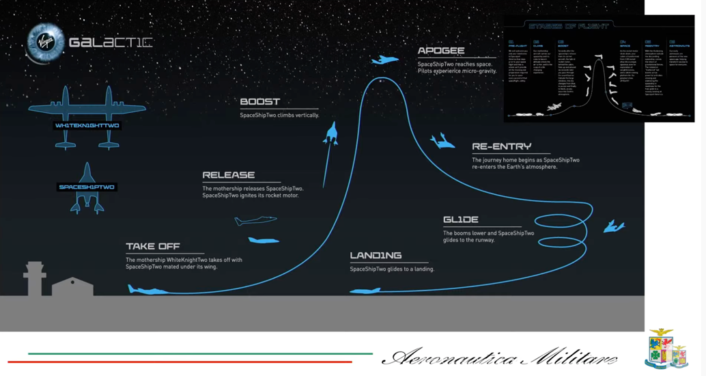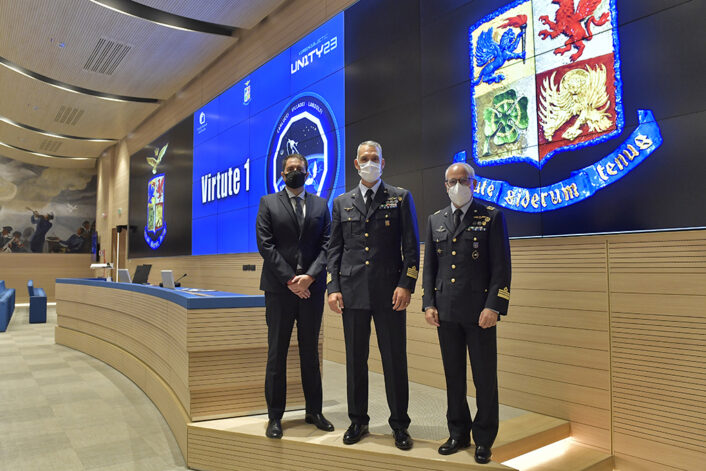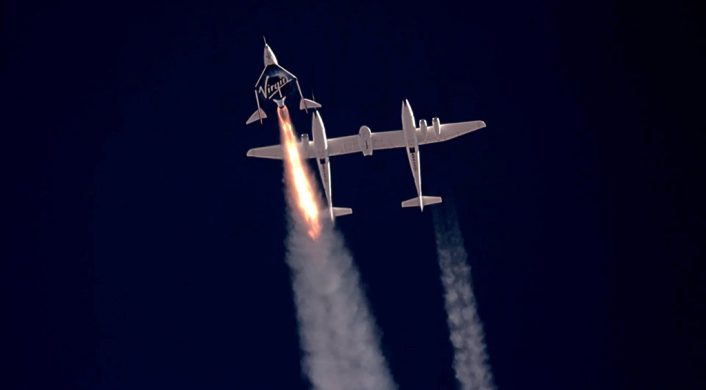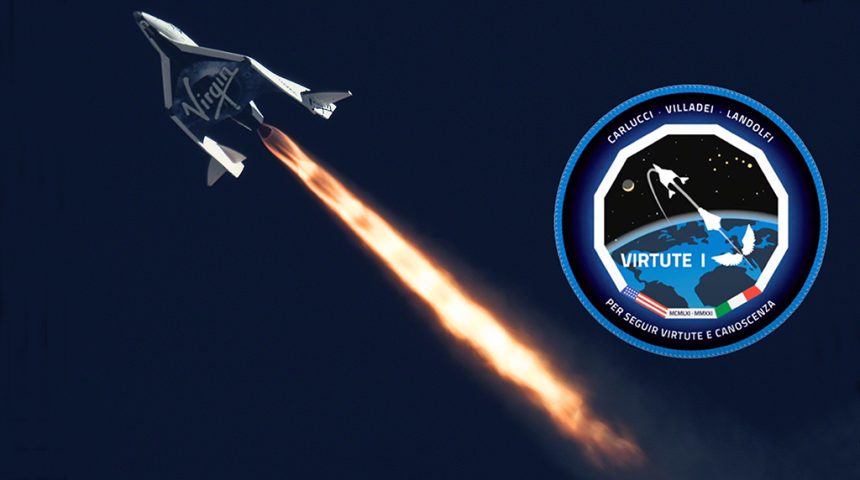Next rocket-powered test flight of SpaceShipTwo Unity from Spaceport America, with three paying crew members from the Italian Air Force and the National Research Council will be the first commercial, human-tended research mission for Virgin Galactic and first mission of its kind led by European country.
The Italian Air Force and the CNR (Consiglio Nazionale delle Ricerche – National Research Council) along with Virgin Galactic outlined the first commercial suborbital mission with SpaceShipTwo, during a press conference held in Rome, Italy, on Sept. 2, 2021.
The mission is dubbed VIRTUTE 1, both an acronym for Volo Italiano per la Ricerca e la Tecnologia sUborbiTalE – Italian Flight For Sub-Orbital Research and Technology, and the Latin word for Valor, that is also in the Italian Air Force motto “Virtute Siderum Tenus” – “With Valor To The Stars”. The mission motto is a famous sentence from Ulysses in the Divina Commedia, Canto XXVI of The Inferno: “Fatti non foste a viver come bruti ma per seguire VIRTUTE e canoscenza” (“You were not made to live like brutes but to follow valor and knowledge”).
The mission, that will be live streamed on Virgin Galactic website, will launch with SpaceShipTwo from Spaceport America, in Las Cruces, New Mexico, in late September or early October 2021, pending technical checks and weather.
“Unity 23”, the 23rd flight for VSS Unity spacecraft will have three paying crew members from the Italian Air Force and the National Research Council. The goal of the mission is to evaluate and measure the effects of the transitional phase from gravity to microgravity on the human body. Other payloads on board will study the effect of the microgravity environment on a range of chemical and physical properties. By testing and evaluating physiological and technological responses in sub-orbital flight, the mission aims to produce insights relevant to current and future spaceflight systems and technologies.
The Italian team will carry out 12 tests in about 3 minutes during the flight that is slated to reach an apogee at 295,000 feet.

The crew will be:
Col. Walter Villadei, Italian Air Force. Col. Villadei, a space engineer and cosmonaut, will serve as mission lead, tending to the rack-mounted payloads during the weightless portion of the flight. He will wear a cutting-edge smart suit, incorporating Italian fashion style and technology, to measure his biometric data and physiological responses.
Lt. Col. Angelo Landolfi, Physician, Italian Air Force. Lt. Col. Landolfi will conduct tests measuring cognitive performance in microgravity. In addition, he will activate syringe payloads from his seat to investigate how certain liquids and solids mix in microgravity.
Pantaleone Carlucci, Aerospace Engineer and National Research Council researcher. Mr. Carlucci will wear sensors that examine heart rate, brain function and other human performance metrics in microgravity.

Beth Moses, Chief Astronaut Instructor, Virgin Galactic. Ms. Moses will serve as cabin lead in space, calling out key mission phases and cabin instructions and overseeing the safe and efficient execution of the flight timeline. She will not interact directly with the Italian experiments.
The pilots for this mission are Michael Masucci and CJ Sturckow flying VSS Unity and Nicola Pecile and Kelly Latimer flying VMS Eve mothership.
“What we present today is an example of a double binomial: the one between the private and public world, but also the one between the civil and military world,” said Lt. Gen. Alberto Rosso, Italian Air Force Chief of Staff. “It is a form of collaboration between institutions serving the country, which team up to develop an incredible opportunity from many points of view: technological research, commercial development, economic growth, also in terms of job offers for young people.”
“I want to use the word “pioneers”, a term that applies to the companies of the past, but which is also suitable for what we are doing today: the exploration of a new environment, full of extraordinary opportunities. I think that the Air Force, despite being pragmatically immersed in everyday reality, “with its feet on the ground”, cannot fail to have an eye on the future, on innovation, on the challenges and perspectives offered by the new environments.”
“It is our precise responsibility to provide support to the country with our capabilities and our preparedness (as demonstrated during the pandemic or with the recent airlift to rescue civilians from Afghanistan), but also to look forward to innovation and research, through the expansion of a domain in which we have been present from the beginning and in which we intend to continue to make a difference, offering our skills and professionalism alongside other institutions, industry, start-ups and forces healthiest in the country.
All this without ever forgetting the proper function of the Air Force, namely Air Defense, which in the near future we will be able to guarantee well beyond the altitude at which we normally operate today.”
Michael Colglazier, Chief Executive Officer of Virgin Galactic, said: “Being selected by the Italian Air Force to support their microgravity research is a testament to the unique scientific capabilities of our spaceflight system. We’re proud to be facilitating cooperation between spacefaring nations and industry pioneers to expand human knowledge, and demonstrate the intrinsic value of our offering to government and scientific partners. This flight will be remembered as an important milestone in unlocking the transformative potential of repeatable and reliable access to space for years to come.”
As most of our readers already know because it made the news less than two months ago, on July 11, 2021, during Unity 22, the 22nd flight, Virgin Galactic launched its first fully crewed flight of its SpaceShipTwo space plane with a special passenger on board: the company’s billionaire founder Richard Branson.

Few hours after the Italian Air Force press conference, SpaceShipTwo was grounded following the July 11 flight, when it deviated from its Air Traffic Control clearance and flew outside its designated airspace for 1 minute and 41 seconds according to FAA.
“Virgin Galactic may not return the SpaceShipTwo vehicle to flight until the FAA approves the final mishap investigation report or determines the issues related to the mishap do not affect public safety,” the FAA said in a statement to CNBC.
“The FAA is responsible for protecting the public during commercial space transportation launch and reentry operations. The FAA is overseeing the Virgin Galactic investigation of its July 11 SpaceShipTwo mishap that occurred over Spaceport America, New Mexico. SpaceShipTwo deviated from its Air Traffic Control clearance as it returned to Spaceport America,” the regulator added.
Let’s see if the grounding affects the targeted launch window of Unity 23.









